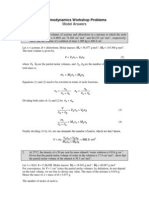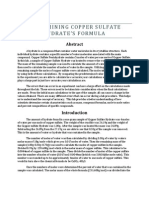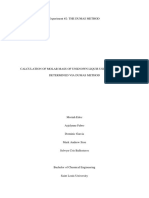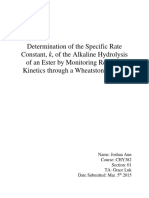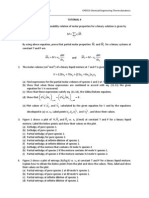Experiment 2
Uploaded by
zidrick benjaminExperiment 2
Uploaded by
zidrick benjaminCHM170L Physical Chemistry 1 Laboratory
2nd Quarter SY 2015-2016
Measurement of Density and Determination of Partial Volume of Ethanol-Water System
Calderon, Edna1,
Benjamin, Zidrick Ed C2, Lola, Ernest Nicolo2,
1
2
Professor, School of Chemical Engineering, Chemistry and Biotechnology, Mapua Institute of Technology;
Student (s), CHM170L/A1, School of Chemical Engineering, Chemistry and Biotechnology, Mapua Institute of Technology
ABSTRACT
This experiment is primarily focused on the measurement of the density and the determination of the partial molar volume of ethanolwater system. A partial molar volume is a thermodynamic quantity defined as a change in volume per mole of substance added to the
mixture at constant temperature and pressure, indicating that molar volumes are non-additive. Solutions of ethanol and water had
been prepared with varying concentrations and a pycnometer was calibrated and used by weighing it along with the liquid samples
one at a time, for the accurate measurement of the density of each mixture. The latter was measured in order to calculate for the
excess molar volume and partial molar volume for both components. The data were then used for calculating other physical
quantities such as molar volume, molar fraction, and molecular weight. For the determination of the partial molar volume of each
component, tangent lines to the curve were drawn from the graph relating the negative excess molar mass of the concentrated
mixture, and the mole fraction of water. From these lines, the y-intercepts at certain points had been identified for the determination of
the partial molar volume of ethanol and water which were used for correlation. Results showed that the partial molar volume of a
substance increases with an increase of its molar fraction. Hence, in this experiment, the partial molar volume of ethanol watermixtures is to be determined using density and specific gravity measurement.
Keywords: density, partial molar volume, pycnometer, mole fraction, tangent lines, excess molar volume
INTRODUCTION
Experiment 02 Group No. 5 October 27, 2015
1 of 8
CHM170L Physical Chemistry 1 Laboratory
2nd Quarter SY 2015-2016
Volume, by definition, is the amount of space occupied
by a substance measured in cubic units. Molar
volume, on the other hand is the volume occupied by
one mole of a solid, liquid, or gas. This experiment
focuses on determining the partial molar volume of
ethanol-water system. Partial molar volume is the
contribution that a component of a mixture makes to
the total volume of a sample [1]. In other words, the
partial molar volume of a substance in a mixture is the
change in volume per mole of the substance added to
the mixture. Moreover, it is the easiest extensive
property to visualize.
Generally, for solutions with different components, the
volumes of the components are not additive. Partly
because the molecules in each component undergo
different intermolecular forces than in pure
substances. For instance, a water molecule, together
with an ethanol molecule, observe a different
interaction than that of two water molecules alone, or
two ethanol molecules alone [2]. Also, the water and
ethanol molecules have various shapes and sizes.
Hence, the molecules of a solution of ethanol and
water fit quite differently than that of pure water and
pure ethanol [3].
Given a system with two components X and Y, the
partial molar volume of the first component X can be
determined mathematically by the equation:
V
V x =(
)
nA T , P ,n
(1)
y
Where V is the total volume ,NX is the number of
molecules of X , NY is the number of molecules of Y, T
is the temperature, and P is the pressure. As can be
seen, the partial volume of X is the change in volume
per mole of X added, assuming that the temperature
and pressure are constant.
This experiment will try to use the concept of partial
molar volume using the materials and methods
provided. The objectives of this experiment are, first, to
be familiarized with the use of pycnometer and the
chain balance for measuring density and specific
gravity, respectively, and second, to determine the
partial molar volume of ethanol-water system at
different concentration using density and specific
gravity measurement.
MATERIALS AND METHODS
I.
Sample Preparation
The solutions needed were initially prepared
as such. One containing pure ethanol, another
with pure water, and several containing a mixture
of both, having different concentrations, with an
increment of 10% by volume for each. By means
of using a graduated cylinder and a pipette, the
necessary amounts of water and ethanol had been
obtained. Shown in Table 1 are the specified and
distinct volume of water and ethanol
respectivelyadded per sample solution to be evaluated.
Table 1. Volume of Each Component of Mixture
Volume of water ,
Volume of Ethanol ,
cm3
cm3
0
30
3
27
6
24
9
21
12
18
15
15
18
12
21
9
24
6
27
3
30
0
II.
Molar Volume Determination
Prior to the actual utilization of the flask with a closefitting ground glass stopper with fine hole through it,
the pycnometer was first calibrated by means of
getting the required measurements. It was initially
weighed dry and then after filling it up with water, the
mass reading was taken note of. The filled-in weight
reading was subtracted to that of the empty reading to
determine the weight of the water alone.
Knowing that the density of water at a temperature of
26C as 0.9983 g/cm3, the corresponding volume of
CHM170L Physical Chemistry 1 Laboratory
2nd Quarter SY 2015-2016
the pycnometer could be ascertained substantially.
a mixture.
Calculations underwent through quite a few
reckonings for the molar volume count. These
included densities, molecular weights, and mole
counts of each differently concentrated solution.
First, the mole count of water and of the
ethanol was measured with the corresponding volume
that both occupied in a solution and then their mole
fractions were obtained varying to the quantity they
occupy. The molar volume of the mixture was
computed with the density and the average molecular
weight which was then identified with the mole
fractions and molecular weights of water and of
ethanol. The density of the mixture was measured with
the mass in grams of the sample and the volume it
occupies. Having the pycnometer weighed with a full
amount, the empty pycnometer weight was simply
subtracted and yielded the mass of the mixture.
Subdividing the average molecular weight with that of
its corresponding density gave the molar volume.
As for the determination of the partial molar
volumes of ethanol and water accordingly, the excess
molar volume of the mixture vs. the mole fraction of
water was plotted. From the graph, tangent lines were
drawn with respect to the curve and specified points
from which the equations of these tangent lines were
known. By getting the y-intercepts at x=0 for the solute
and x=1 for the solvent, the partial molar volume of the
ethanol-water system could be determined.
The change in molar volume due to mixing
was calculated by differentiating the computed molar
volume with the appropriate molar volume. This value
tells the increment in volume with that of a pure and of
Figure 1. Pynometer with Thermometer
RESULTS and DISCUSSIONS
V1 (water) V2 (ethanol)
0
30
3
27
6
24
9
21
12
18
15
15
18
12
21
9
24
6
27
3
30
0
M1
0
0.166
0.332
0.498
0.665
0.831
0.997
1.163
1.329
1.495
1.661
M2
0.511
0.460
0.409
0.358
0.307
0.256
0.205
0.153
0.102
0.051
0
X1
0
0.265
0.448
0.582
0.684
0.765
0.830
0.884
0.928
0.967
1
Mavg, g/mol mix, g/cm3 , cm3/mol mix, cm3/mol
46.068
0.998
46.160
-12.548
38.634
1.031
37.472
-13.451
33.501
1.065
31.456
-9.030
29.742
1.088
27.336
-7.711
26.880
1.126
23.872
-6.992
24.636
1.156
21.311
-6.288
22.812
1.180
19.332
-5.626
21.269
1.191
17.858
-4.938
20.035
1.219
16.436
-4.528
18.941
1.231
15.387
-4.018
18.015
1.243
14.493
-3.568
Table 2 Molar Volumes of Ethanol-Water mixture at different concentrations
CHM170L Physical Chemistry 1 Laboratory
2nd Quarter SY 2015-2016
Ethanol-water
solutions
of
different
concentrations had been prepared and each of them
had been placed in the pycnometer and then weighed
afterwards. A pycnometer had been used in order for a
given volume and density to be accurately obtained by
reference to an appropriate working fluid, using an
analytical balance.
At the start of the experiment, you would need
to calibrate the pycnometer to reduce and minimize
errors in computations of the different values. You
could see on table 1 the result in calibration of the
pycnometer.
Table 3. Calibration of Pycnometer
Weight
of
empty
pycnometer
Weight
of
empty
pycnometer + water
Temperature of water, T
Density of water at T
Volume of pycnometer
32.319 g
52.019 g
Figure 2.1.Average molecular weight/ Molar volume of the
mixture VS mole fraction of water.
In table 2, the density of the solution increases
since the density of ethanol is lower than water(Figure
2.2). The molar volume of the mixture decreases
because of the presence of hydrogen bond, these
makes the distance between molecules of ethanol and
water smaller(Figure 2.1).
From the data gathered, it could be observed
that there is a trend between concentration of solution
and the density of the mixture. This relationship could
further be elaborated by having the illustrated graph as
follows:
26 C
0.9983 g/cm^2
19.73 ml
After the calibration of the pycnometer, we
performed the measuring of masses of different
concentration of ethanol-water solution. In table 2, the
data such as the masses, number of moles, mole
fraction, average molecular weight and molar volume
of the mixture at different concentration can be seen.
As you can see on table 2 that the average
molecular weight of the mixture decreases as you
increase the concentration of water in the mixture,
because the water has a lower molecular weight than
the water(Figure 2.1).
Figure 2.2.Density of mixture VS mole fraction of
water graph.
In addition, the Vmix column in table has a
distinct noticeable data that we can concur. Both the
pure ethanol and pure water has a positive data, while
the mixed solutions have negative. This leads to the
conclusion that the intermolecular molecules affect the
mixture of the solution. Since we know that both the
ethanol and water are polar protic solvents, they are
miscible with each other, thus interacting between the
two.
The pure water has higher value than that of
the pure ethanol; this also leads to the fact that the
CHM170L Physical Chemistry 1 Laboratory
2nd Quarter SY 2015-2016
water has stronger intermolecular force that exhibits
hydrogen bonding. Also, the data from the mixture also
supports the conclusion because the more the volume
of water increases, the higher the value of the V mix.
Where V1 V1* is obtained from the y-intercept of the
tangent lines, V1 stands for the volume of ethanol, obtained
by dividing the molar masses of ethanol over its density,
and V1* for the partial molar volume of ethanol.
For Ethanol, the table below shows a summary of its
partial molar volume for each concentrated solution:
X1, ml
V1 V1*
V1*
V1
59.7795897
0.5941 19.73
5
0
19.73
59.040299
-
To clearly understand the relationship between the partial
molar volume of ethanol and the mole fraction of water, an
illustration showing how these two are related is shown:
0.265
0.448
0.582
0.684
0.764
0.829
0.884
0.928
0.967
1
1.2204
2
2.4621
2
3.3765
7
4.0713
1
4.6185
4
5.0613
5
5.4254
7
5.7317
7
5.9912
3
0
19.73
58.498829
19.73
57.778079
19.73
56.711289
19.73
56.333329
19.73
53.733329
19.73
52.007419
19.73
50.2193790
Figure 3.2.Partial Molar Volume of Ethanol VS mole of
Water
The graph portrays that as the mole fraction of
water increases, the partial molar volume of ethanol
decreases. In addition, it could be observed that the
more dilute the solution is, the lower is the partial
molar volume of ethanol.
In the case of water, the table below shows
the summary of the data obtained for each mole
fraction.
X1, ml
19.73
48.4198690
V2 V2*
0
0.265
Table 3.1.Determination of Partial Volume of Ethanol.
0.448
0.582
0.5941
5
1.2204
2
2.4621
2
3.3765
V2*
18.018
99
V2
18.18182
15.1406
18.018
99
16.0936
18.018
99
18.054 16.7333
16
CHM170L Physical Chemistry 1 Laboratory
2nd Quarter SY 2015-2016
0.684
0.764
0.829
0.884
0.928
0.967
1
7
4.0713
1
4.6185
4
5.0613
5
5.4254
7
5.7317
7
5.9912
3
6.2161
5
17.3195
18.054
16
18.8190
18.054
16
18.2078
18.065
03
18.4842
18.054
16
Figure 3.2. Partial Molar Volume of Water VS Mole of
Water
18.6617
18.054
16
18.7566
18.054
16
18.7850
18.054
16
Table 3.2. Determination of Partial Volumes of Water
Where V2 - V2* represents the y-intercept of the tangent line
at x=1, V2 stands for the volume of water, obtained by
dividing the molar mass of water over its density, and V2* for
the partial molar volume of water.
Plotting there points and data in a graph would produce an
outcome to:
The graph suggests that when the mole of water
increases the partial molar volume of water increases
as well.
Water and ethanol will always have a negative excess
volume when mixed;indicating the partial molar volume
of each component is less when mixed than its molar
volume when pure.
The partial molar volume of the components of a
mixture will always vary by its composition because
when the two is mixed the environment of the two is
changed, thus the interaction between the molecules
also changed. Or we can also suggest that the
composition of the mixture wherein the larger is its
contribution to the mixture, the larger is the partial
molar volume.
CHM170L Physical Chemistry 1 Laboratory
2nd Quarter SY 2015-2016
CONCLUSIONS AND RECOMMENDATIONS
REFERENCES
In the experiment, different concentration of
ethanol-water system was prepared. The calibrated
pycnometer was used to obtained masses of the
different concentrations of ethanol-water mixture
needed for the computations of the necessary data
required to determine the partial-molar volume of the
system. The necessary data includes the number of
moles, mole fraction, average molecular weight and
molar volume of the mixture at different concentration.
To show the some of the relationships of the data
obtained certain graphs were made. These graphs
include the relationship of the average molecular
weight and molar volume of mixture vs. the mole
fraction of water, density of mixture vs mole fraction of
water,Vmix vs mole fraction of H2O and the like.
Furthermore, the tangent lines of the curve was
determined to calculate the partial volume of ethanol
and water at the given mole fraction of ethanol and
water.
In the experiment, certain relationships in the
ethanol-water mixture ware observed. It was observed
that the average molecular weight of the mixture
decreases as you increase the concentration of water
in the mixture. Also, as the volume of water increases
and the volume of ethanol decreases, the weight of the
mixture increases. According to the results, the pure
water has higher value than that of the pure ethanol,
this leads to the fact that the water has stronger
intermolecular force that exhibits hydrogen bonding.
Moreover, water and ethanol will always have a
negative excess volume when mixed which indicates
the partial molar volume of each component is greater
when both components are pure.
[1] Caparanga A., Baluyut J.Y.G, and Soriano A.
(2006) Physical Chemistry Laboratory Manual Part 1
[2] Levine I (2009) Physical Chemistry, Fifth Edition
[3] Atkins, P. W., & de Paula, J. (2006). Atkins physical
chemistry (8th ed). Oxford: Oxford UniversityPress.
[4] Imai, T. (2007). Molecular Theory of Partial Molar
Volume and Its Application to Bimolcular Systems.
Department of Bioscience and Bioinformatics,
Ritsumeikan University. P.525
[5] Engel, T. (2006). Physical Chemistry, p.210
Sample Computations:
Part B
m1 moles of distilled water
3
m 1=
V 1 w
=
MM w
(3 cm )(0.9983
g
)
3
cm
g
( 18
)
mol
=0.166 moles
m2 moles of ethanol
m 2=
V 2 e
=
MM e
( 30 cm 3 ) 0.7847 g 3
cm
(46. 07 molg )
) =0.511 moles
x1 mole fraction of water
m1
0.166
x 1=
=
=0.265
m1 +m2 0.166 +0.460
Mavg average molecular weight of mixture
CHM170L Physical Chemistry 1 Laboratory
2nd Quarter SY 2015-2016
MM w
)+(1-x1)(MMe)
M avg=x 1
18 g
46.07 g
M avg=0.265
+ ( 10.265 )
mol
mol
38.634 g
M avg=
mol
( )
mix density of the mixture
m
46.068 g
mix =
=
=0.998 g /cm3
3
V pycnometer 19.73 cm
V molar volume
M
V = avg =
mix
g
mol
cm3
=46.160
g
mol
0.998 3
cm
46.07
Vmix molar change in volume
30 cm 3
cm 3
30 cm 2
V mix =V
=46.160
=12.548 cm3 /mol
ntotal
mol ( 0+0.511 ) mol
You might also like
- Ion Mobility: Transference Number of Ions (ION) and Analysis of Electrochemical Reactions (ECR)No ratings yetIon Mobility: Transference Number of Ions (ION) and Analysis of Electrochemical Reactions (ECR)16 pages
- Thermodynamics Workshop Problems Model Answers 2010-2011 1No ratings yetThermodynamics Workshop Problems Model Answers 2010-2011 19 pages
- Initial Concentration of NaOH in Feed VesselNo ratings yetInitial Concentration of NaOH in Feed Vessel2 pages
- The Principles of Chemical Equilibrium-4thEd-Denbigh PDF100% (1)The Principles of Chemical Equilibrium-4thEd-Denbigh PDF514 pages
- Solution Thermodynamics: Theory: Partial PropertiesNo ratings yetSolution Thermodynamics: Theory: Partial Properties20 pages
- EXP5-Determination of Partial Molar QuantitiesNo ratings yetEXP5-Determination of Partial Molar Quantities2 pages
- Formal Report On Partial Molar Volume Experiment100% (2)Formal Report On Partial Molar Volume Experiment9 pages
- Spectrophotometric Determination of The Acid Dissociation Constant of Methyl RedNo ratings yetSpectrophotometric Determination of The Acid Dissociation Constant of Methyl Red3 pages
- A Solution Contains 5 G of Urea (M2 60.05) Per 100 G of Water. What Will Be The Vapor Pressure of This Solution at 25100% (1)A Solution Contains 5 G of Urea (M2 60.05) Per 100 G of Water. What Will Be The Vapor Pressure of This Solution at 2521 pages
- A Constant Volume Batch Reactor For Saponification Reaction PDFNo ratings yetA Constant Volume Batch Reactor For Saponification Reaction PDF49 pages
- 3417 Che 2131L - Experiment 1 - Moriah EdocNo ratings yet3417 Che 2131L - Experiment 1 - Moriah Edoc53 pages
- Experiment No. 7 Measurement of Reaction ConversionNo ratings yetExperiment No. 7 Measurement of Reaction Conversion8 pages
- Branching Applications: Ch.E. 412: Topic 2dNo ratings yetBranching Applications: Ch.E. 412: Topic 2d25 pages
- f2 Sedimentation Practical Report For s3 LevelNo ratings yetf2 Sedimentation Practical Report For s3 Level17 pages
- Ch116L: Physical Chemistry (Laboratory) 1 Quarter SY 2019-2020No ratings yetCh116L: Physical Chemistry (Laboratory) 1 Quarter SY 2019-20208 pages
- Che 514L: Chemical Engineering Lab Ii Experimental Report: Bilog, Josef AntonioNo ratings yetChe 514L: Chemical Engineering Lab Ii Experimental Report: Bilog, Josef Antonio11 pages
- Topics: Psychro. Evaporative, Cooling & Solids Drying Energy Resources Conversion & UtilizationNo ratings yetTopics: Psychro. Evaporative, Cooling & Solids Drying Energy Resources Conversion & Utilization3 pages
- EXP5-Determination of Partial Molar QuantitiesNo ratings yetEXP5-Determination of Partial Molar Quantities2 pages
- Sample Laboratory Report_0acc7cabbe9e9b04f60a1d6e5ffa37fbNo ratings yetSample Laboratory Report_0acc7cabbe9e9b04f60a1d6e5ffa37fb17 pages
- Experiment 5 - Determination of Partial Molar QuantitiesNo ratings yetExperiment 5 - Determination of Partial Molar Quantities2 pages
- Continuous Stirred Tank Reactor: ExperimentNo ratings yetContinuous Stirred Tank Reactor: Experiment9 pages
- Experiment 402 Plane and Spherical Mirrors (Analysis and Conclusion)No ratings yetExperiment 402 Plane and Spherical Mirrors (Analysis and Conclusion)2 pages
- Get Activity coefficients in electrolyte solutions Second Edition Pitzer PDF ebook with Full Chapters Now100% (1)Get Activity coefficients in electrolyte solutions Second Edition Pitzer PDF ebook with Full Chapters Now55 pages
- Propiedades Molares Parciales-Método GraficoNo ratings yetPropiedades Molares Parciales-Método Grafico2 pages
- Property Relationships For Mixtures: in in in If inNo ratings yetProperty Relationships For Mixtures: in in in If in70 pages
- Thermodynamics of Physical and Chemical Vapour Deposition: 2.1 Ideal GasesNo ratings yetThermodynamics of Physical and Chemical Vapour Deposition: 2.1 Ideal Gases31 pages
- Uncovering The Realities of Simulation, Part 1 (Of 1)100% (2)Uncovering The Realities of Simulation, Part 1 (Of 1)11 pages
- Exergy Analysis in ProSimPlus SimulationNo ratings yetExergy Analysis in ProSimPlus Simulation22 pages
- 3.1. Excess Thermodynamic, Transport and Acoustic PropertiesNo ratings yet3.1. Excess Thermodynamic, Transport and Acoustic Properties8 pages
- Thermodynamics of Solutions and Electrochemistry: 22306 Physical Chemistry INo ratings yetThermodynamics of Solutions and Electrochemistry: 22306 Physical Chemistry I127 pages
- Ion Mobility: Transference Number of Ions (ION) and Analysis of Electrochemical Reactions (ECR)Ion Mobility: Transference Number of Ions (ION) and Analysis of Electrochemical Reactions (ECR)
- Thermodynamics Workshop Problems Model Answers 2010-2011 1Thermodynamics Workshop Problems Model Answers 2010-2011 1
- The Principles of Chemical Equilibrium-4thEd-Denbigh PDFThe Principles of Chemical Equilibrium-4thEd-Denbigh PDF
- Solution Thermodynamics: Theory: Partial PropertiesSolution Thermodynamics: Theory: Partial Properties
- Spectrophotometric Determination of The Acid Dissociation Constant of Methyl RedSpectrophotometric Determination of The Acid Dissociation Constant of Methyl Red
- A Solution Contains 5 G of Urea (M2 60.05) Per 100 G of Water. What Will Be The Vapor Pressure of This Solution at 25A Solution Contains 5 G of Urea (M2 60.05) Per 100 G of Water. What Will Be The Vapor Pressure of This Solution at 25
- A Constant Volume Batch Reactor For Saponification Reaction PDFA Constant Volume Batch Reactor For Saponification Reaction PDF
- Experiment No. 7 Measurement of Reaction ConversionExperiment No. 7 Measurement of Reaction Conversion
- Ch116L: Physical Chemistry (Laboratory) 1 Quarter SY 2019-2020Ch116L: Physical Chemistry (Laboratory) 1 Quarter SY 2019-2020
- Che 514L: Chemical Engineering Lab Ii Experimental Report: Bilog, Josef AntonioChe 514L: Chemical Engineering Lab Ii Experimental Report: Bilog, Josef Antonio
- Topics: Psychro. Evaporative, Cooling & Solids Drying Energy Resources Conversion & UtilizationTopics: Psychro. Evaporative, Cooling & Solids Drying Energy Resources Conversion & Utilization
- Sample Laboratory Report_0acc7cabbe9e9b04f60a1d6e5ffa37fbSample Laboratory Report_0acc7cabbe9e9b04f60a1d6e5ffa37fb
- Experiment 5 - Determination of Partial Molar QuantitiesExperiment 5 - Determination of Partial Molar Quantities
- Experiment 402 Plane and Spherical Mirrors (Analysis and Conclusion)Experiment 402 Plane and Spherical Mirrors (Analysis and Conclusion)
- Get Activity coefficients in electrolyte solutions Second Edition Pitzer PDF ebook with Full Chapters NowGet Activity coefficients in electrolyte solutions Second Edition Pitzer PDF ebook with Full Chapters Now
- Property Relationships For Mixtures: in in in If inProperty Relationships For Mixtures: in in in If in
- Thermodynamics of Physical and Chemical Vapour Deposition: 2.1 Ideal GasesThermodynamics of Physical and Chemical Vapour Deposition: 2.1 Ideal Gases
- Uncovering The Realities of Simulation, Part 1 (Of 1)Uncovering The Realities of Simulation, Part 1 (Of 1)
- 3.1. Excess Thermodynamic, Transport and Acoustic Properties3.1. Excess Thermodynamic, Transport and Acoustic Properties
- Thermodynamics of Solutions and Electrochemistry: 22306 Physical Chemistry IThermodynamics of Solutions and Electrochemistry: 22306 Physical Chemistry I


